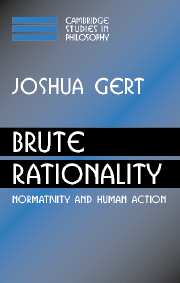Book contents
- Frontmatter
- Contents
- Preface and acknowledgements
- 1 What would an adequate theory of rationality be like?
- 2 Practical rationality, morality, and purely justificatory reasons
- 3 The criticism from internalism about practical reasons
- 4 A functional role analysis of reasons
- 5 Accounting for our actual normative judgments
- 6 Fitting the view into the contemporary debate
- 7 Two concepts of rationality
- 8 Internalism and different kinds of reasons
- 9 Brute rationality
- References
- Index
4 - A functional role analysis of reasons
Published online by Cambridge University Press: 22 September 2009
- Frontmatter
- Contents
- Preface and acknowledgements
- 1 What would an adequate theory of rationality be like?
- 2 Practical rationality, morality, and purely justificatory reasons
- 3 The criticism from internalism about practical reasons
- 4 A functional role analysis of reasons
- 5 Accounting for our actual normative judgments
- 6 Fitting the view into the contemporary debate
- 7 Two concepts of rationality
- 8 Internalism and different kinds of reasons
- 9 Brute rationality
- References
- Index
Summary
In the previous two chapters a great deal of attention was paid to the notion of a practical reason. In chapter 2, the justifying and requiring roles of these sorts of reasons were distinguished, and in chapter 3 this distinction was further developed. But even in chapter 2, one might have noticed that the roles of justifying and requiring were explained in terms of an antecedent notion of rationality. For example, the justifying role is the role of making an action rational, when otherwise it would be irrational. Unless we have some idea what ‘rational’ and ‘irrational’ mean, this claim will make little sense. What emerged more or less explicitly in chapter 3 was that the need to distinguish between these two roles for practical reasons depends in an important way on what principles of rationality we are willing to recognize. Principles that have the form of P imply that some reasons can play a justifying role without being able to play a requiring role at all. And principles similar to Q allow that some reasons might be able play a very significant justifying role without being able to play much of a requiring role. So, perhaps despite appearances, the basic normative notion that has been used so far in this book has not been the notion of a reason for action.
- Type
- Chapter
- Information
- Brute RationalityNormativity and Human Action, pp. 62 - 84Publisher: Cambridge University PressPrint publication year: 2004



